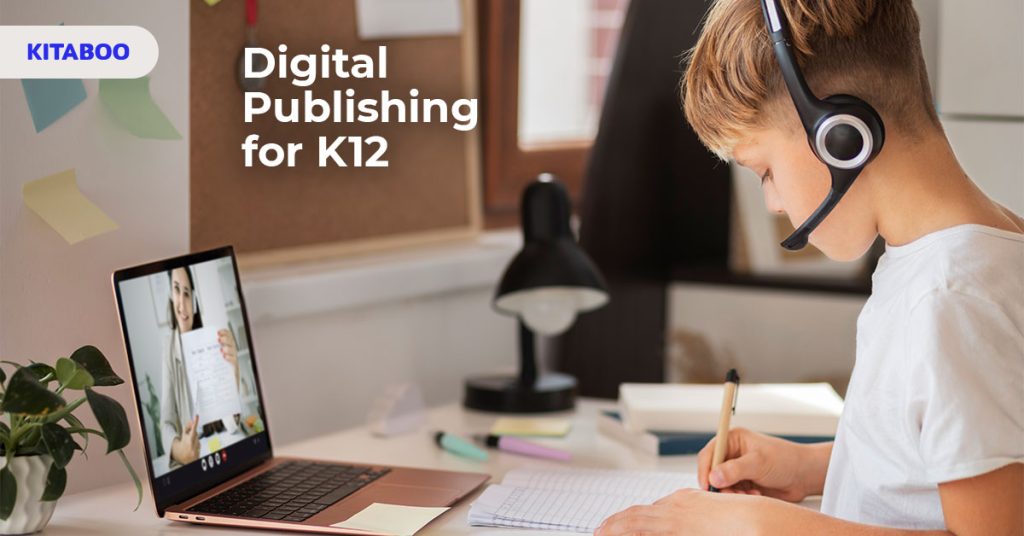
Digital Publishing: The Future of K12 Education
Summarize this blog with your favorite AI:
The landscape of K12 publishing has undergone a revamp in the past few years. The global eBook market size is expected to reach $32.19bn by 2032. With a projected compound annual growth rate (CAGR) of 4.9% during 2022-2032, the educational eBook publishing market shows no signs of slowing down.
One segment of education that is desperately in need of capturing data about its readers is K12 education. Furthermore, several modern digital learning solutions like learning management systems, interactive eBooks, and hands-on learning methodologies are steadily becoming popular in the K12 publishing landscape with the promise of providing an immersive learning experience.
In this article, we’ll explore how digital publishing poses a challenge to traditional publishing, making it the future of K12 education.
The Decline in Print Publishing
The first edition/revision model started losing effectiveness much before the pandemic. Big names in the industry such as Pearson, began adopting a digital-first approach. And then the pandemic hit; bringing with it a further decline in print sales. Major technology giants such as Microsoft and Google have also invested in digital educational projects.
With these developments, it’s undeniable that print is gradually becoming more outdated in the digital era. K12 publishers have clearly made a strategic choice to remodel or widen their portfolios through digital products.
So, what exactly brought about this change in the education industry.
Let’s take a closer look.
Why Have K12 Publishers Moved from Print to Digital?
Digitization has opened a whole new set of possibilities for educational publishers.
To begin with, it helps them design highly interactive eBooks across multiple platforms that essentially widens their readerbase.
With the presence of Open Educational Resources (OERs), publishers realize the need to create relevant K12 content solutions. Digitization also gives publishers the opportunity to use big data to curate their content.
Most importantly though, digital book distribution is highly cost-effective as compared to print distribution. This allows publishers to provide quality eBooks at affordable prices; a win-win for all concerned.
While K12 publishers might have embraced the digital era, let’s explore if institutions have done the same.
Is the Move from Print to Digital Beneficial to K12 Classrooms?
One of the biggest reasons for institutions to favor both textbook conversion (from print to digital) and the adoption of digital-first content, is access to learner analytics. These have proven to be extremely useful in providing quality K12 content. Here’s why:
- Track Student-Engagement Levels: Through a learner analytics report, educators can track the engagement levels of students. This gives them detailed insights about the time spent by individual students on a certain topic and helps ascertain how engaging the subject-matter is.
- Draft Customized Learning Plans: Educators can identify the learning capacity of each student using the analytics report. This helps them customize their lesson plans as per the strengths and weaknesses of the class. With this information, they can also create engaging student assessment platforms.
- Identify Academically Weak Students: Learning analytics also offer detailed insight into each student’s performance. This helps educators identify students who might be struggling to grasp the concepts being taught. By using this information to provide these students with additional attention, educators can help them overcome their challenges.
- Modify the Course Module If Necessary: Most importantly, the insights gained from a learning analytics report helps educators pinpoint exactly where the course is lacking and make adjustments accordingly. As eBook content is cloud-based, it is simple to update it.
Learning analytics can be a useful K12 content solution to enhance the students’ learning experience from the educators perspective. However, for digital publishing to truly be the future of K12 education, we’ll have to look at how it impacts the end customer i.e. – The student.
How Does the Move from Print to Digital, Impact K12 Students?
At the best of times, most students don’t listen to what adults have to say. Yet when it comes to online K12 content solutions, everyone seems to be in agreement?! Here are some reasons why students are embracing the move from print to digital.
- More Interesting Content: Digitization allows for creators to enhance study-material. Embedded with interactive elements and multimedia such as images, videos, audio, animation, etc. eBooks have the ability to capture a student’s imagination. This comes as a pleasant change for students from having to read text-heavy printed study materials.
- Communicating via the Right Channel: Traditionally, one of the biggest problems in education was the disconnect between teacher and taught. With students becoming increasingly digitally-adept, providing study-material via a channel they use regularly, makes them more receptive to learning.
- Easy Access to Additional Resources: Whether it’s an online search, or additional reading material, eBooks can be embedded with as many resources as one wishes. This helps students save time and effort on research. And with access to all the additional resources they may need at no extra cost, it’s no surprise that students favor the move to digital.
- Addresses Multiple Learning Styles: One major benefit of digital learning over print for K12 students is the fact that it addresses multiple learning styles. Whether a student retains more by listening, watching videos or just reading plain text, with digital content one has a choice.
Additionally, easy navigation and layout and features such as annotations, bookmarking, text highlighting etc., give students a seamless reading experience.
Wrapping Up
Needless to say, every major stakeholder in the K12 education sector benefits from digital publishing in some way or the other. Yet, not everyone has adapted to it. The first stumbling block could be choosing the right authoring tool. The tool one chooses must not only cater to one’s needs, it must also allow for publishing across multiple platforms and devices.
A good place to start is with KITABOO. KITABOO is a cloud-based publishing platform that can help create, deliver and enhance a wonderful eBook experience for learners and educators alike. It also allows publishers to share their content with DRM protection. If, as we say, digital publishing is the future of K12 education, it’s in your best interest to equip yourself well.
To know more, write to us at contact@kitaboo.com.
Also check:
Discover how a mobile-first training platform can help your organization.
KITABOO is a cloud-based platform to create, deliver & track mobile-first interactive training content.


